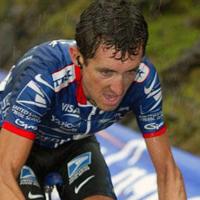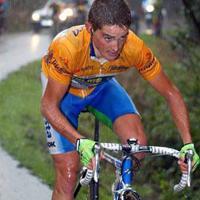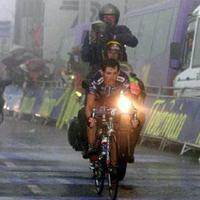
Recently on Cyclingnews.com |
Tales from the peloton, September 11, 2008
Agony in Asturias

|
They either hate it or detest it. No sane cyclist - professional or otherwise - would climb the Alto del Angliru for fun. But for all those whose sentiments for the hardest climb in the world are the polar opposite of affection, no one will argue that whoever wins this stage of the Vuelta a España will become a legend.
Used just three times in the past, the list of winners on Alto del Angliru is a who’s who of the most explosive and exciting climbers in recent history. But what makes the climb, first used in 1999, so exciting for the fans is that they get to see their heroes suffer like mere mortals.
"We’re not animals and this is inhuman," David Millar cursed while refusing to cross the line in 2002.
Having crashed descending the Cordal and gone down again when hit by a team car, Millar rode to the finish, tore off his number, and told the bedraggled press corps exactly what he thought of the stage.
"Half the field was wiped out the previous year - and there are other and safer ways in. But in the wet they sent us over again, and loads crashed," Millar explained. "I had already had a heavy crash, and then got hit by the car. That was what I was protesting about. I was dripping with blood, and they were treating us like performing bears on bikes.
"The police held back the crowds, and then fenced them off so there was no pushing allowed," he added. "Everyone had talked about a protest, it just happened to be me that did it."
Legend in the making
Although it is the most mountainous country in Western Europe after Austria, Spain has relatively few legendary climbs considering it hosts one of the sport’s three major Tours.
The introduction of the huge ascent to the Sierra Nevada ski station in 1979 went a little way towards rectifying this aberration, but Spain’s mountainous reputation was given a tremendous boost when what had recently been no more than a goat track was introduced to the race in 1999.
The Alto del Angliru was infamous even before that year's race started as reports flooded in of its ridiculously steep slopes. "Nothing like this has been seen before," two-time Vuelta winner Pedro Delgado declared after returning from a reconnaissance trip of the climb which has an average gradient of over 10 percent for 12.6 kilometres.
"Some riders will be getting off their bikes here," he rightfully predicted, no doubt referring to the section of the climb which reaches 23 percent.
That year's race was stupidly tough, with three consecutive summit finishes in the Pyrenees. The Angliru came at the end of what was the race’s key stage in Asturias, crossing the first-category Cobertoria and Cordal before.

|
The epic nature of the day was heightened by dreadful weather that saw riders crashing all over the place before they even reached the monstrous final challenge. Race leader Abraham Olano was among those who went down, his crash on the Cordal taking him off into the roadside foliage, where he suffered broken ribs, which later forced him to abandon.
Victory went to Spanish idol José Maria Jimenez, who overhauled an almost stationary Pavel Tonkov in the final kilometre. "I knew the Vuelta’s organisers had programmed this stage with me in mind," he said. "I didn't want to let them down."
The Vuelta returned the following year, when Gilberto Simoni was the victor. Eventual race winner Roberto Heras was not far behind, but even the flyweight Spanish climber, winner on the mountain in 2002, admitted the climb is brutal. "You go at nine kilometres an hour," he explained. "It's hell. There’s nothing remotely like it."
That 2002 stage also saw Kelme’s Aitor Gonzalez attack his own Kelme team captain and race leader Oscar Sevilla, and then go on to take the title in Madrid despite Sevilla’s claims of betrayal.
This year’s stage should see the overall classification reshuffled as a result of the climb. Among the top 10 riders there are several candidates for the stage win.
Alberto Contador is the obvious choice to take the win. The speed and ease at which he can accelerate on a climb is something to behold of which we haven’t seen since Maria Jimenez back in the early 2000s.
Robert Gesink should also not be discounted and will surely hope to once again show his class as a climber. A win here by the Dutchman may even start an affinity with the climb for the Dutch, much like they have with the Alp d’Heuz.
But the odds are firmly stacked in the favour of the Spanish; two wins from three attempts make sure of that. So it may well be Alejandro Valverde Belmonte (Caisse d'Epargne) who cements his name in the history of Spanish cycling with his explosive power on the 23 percent grades this time around.
Not just tough for the riders

|
Almost comically the climb is not only the hardest that the riders will face in this edition of the Vuelta, or any race for that matter, it is also a nightmare logistically. Due to the extreme grades, the organisers will begin carting the infrastructure needed for the stage finish on the evening before the stage.
"It's the most difficult location for a stage finish on the Vuelta," Andres Muñoz, the Vuelta’s logistical director explained in 2002. "The vehicles carrying the infrastructure needed to start going up there at six [o’clock] the evening before the stage and it can take until six the next morning before they’ve all made it. They go up one by one, and we have two breakdown trucks on hand so that we can remove any vehicle that gets stuck. And after all that, we have to get the whole race back down again."
The climbs presence in the race is mainly thanks to the resurfacing of the goat-track that once weaved its way up the mountain. But recognition should also be given to the component manufactures.
"Climbing the Angliru would have been impossible 20 years ago simply because the gears we used were too high," was how former British pro Graham Jones put it. "It's only advances in equipment that enable races to be taken up climbs like that now."
The fans are thanking you Shimano, SRAM, Campagnolo et al, but it is hard to imagine that the riders in the 2008 Vuelta España will be doing the same come Saturday afternoon.
Photography
For a thumbnail gallery of these images, click here
Images by AFP
- Roberto Heras (USPS) leaves Aitor Gonzalez (Kelme) behind on the rain soaked slopes of the Alto de l'Angliru
Images by Lavuelta.com
- Roberto Heras (USPS) driving through the rain on the Angliru
- Oscar Sevilla (Kelme) trying to limit the damage on the Alto de l'Angliru
- Roberto Heras (USPS) emerges from the fog to win the Angliru stage
